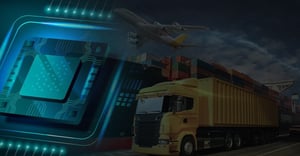Cross-border transportation connectivity is crucial for fleets due to factors like reliability, availability, and affordability. It makes complexities such as customs paperwork, security clearances, and safety issues far easier than it would otherwise be.
To ensure safety in cross-border fleet operations, continuous and even real-time communications are critical. But it’s often easier said than done as mobile communications services can end up being unnecessarily rigid.
For CSPs this provides a unique opportunity to address the needs of fleets – if they partner with the right platform for eSIM connectivity.
The role of communications in international fleets
International fleets – whether cars, trucks, or ships, need ongoing connectivity. Continuous connectivity is crucial for cross-border fleets for several reasons:
- Real-time tracking and route optimization: dispatchers can monitor vehicle location, allowing for better route planning, improved delivery times, and quicker response to unexpected delays or issues at border crossings.
- Clear communication: drivers can receive updates on traffic conditions, weather alerts, or changes in regulations at border points, ensuring smoother journeys. They can also communicate any problems encountered on the road, like breakdowns or accidents, enabling faster assistance.
- Emergency response: in case of accidents or breakdowns, drivers can immediately contact emergency services or roadside assistance, improving response times and ensuring driver safety.
- Cargo tracking and theft prevention: real-time tracking of trailers helps prevent theft and allows for faster recovery of stolen goods.
- Electronic logging devices (ELDs): Many countries mandate ELDs for commercial vehicles. Mobile connectivity ensures these devices can transmit driver activity data like hours of service electronically to authorities, simplifying compliance.
Mobile communications also ensure that electronic documentation can be shared with customs officials at border crossings, expediting the process.
Challenges with cross-border communications
Maintaining communication across borders can be challenging. Mobile signal strength can be patchy in remote areas, especially near borders. This can lead to dropped calls, disrupted data transmission, and communication blackouts.
A bigger concern is data roaming charges which can be exorbitant when crossing borders. Fleets may hesitate to use data services freely, hindering real-time communication and updates.
Some fleets must rely on satellite communications – ships at sea, for example – which carries its own costs – but, worse, these ships often remain connected to expensive satellite connections when near shore, when there is an opportunity to shift to a cheaper terrestrial connection.
Finally, data privacy regulations can restrict how driver and fleet information is collected, stored, and shared across borders, potentially hindering communication and compliance efforts.
What is eSIM?
One way to address many of these challenges is using an eSIM (embedded SIM) platform for connectivity. Traditional SIM cards are physical chips that users insert into devices, while eSIMs are embedded directly into the device's circuitry, making them inaccessible to users.
It means that eSIM technology is more versatile, allowing for multiple profiles and easier switching between carriers without the need to physically change cards. However, due to the complexity of development, eSIMs tend to be more expensive than traditional SIM cards.
One of the significant advantages of eSIMs is their ability to automatically switch networks, making them ideal for devices that need to move across borders and coverage zones seamlessly.
How eSIM improves cross-border connectivity
eSIM technology plays a significant role in the context of cross-border transportation connectivity for fleets. Here's why:
- Automatic network swapping: eSIMs can automatically switch networks, making them ideal for devices that need to move across borders and coverage zones, ensuring seamless connectivity. For example, when a fleet at sea relies on expensive satellite connectivity, eSIM can ensure that it automatically switches to cheaper land-based mobile connectivity.
- Enhanced security: With the increasing need for secure communication and data protection across borders, eSIM technology provides a secure means of communication for fleets operating internationally
- Tracking across borders: eSIMs offer fleets the ability to track vehicles and products effortlessly across borders and various coverage zones, enhancing operational efficiency and visibility
- Roaming benefits: The use of eSIM technology in roaming, especially in regions like Asia, provides undeniable advantages such as convenience, cost savings, and improved connectivity for travellers and fleets operating in diverse locations.
eSIM technology is a game-changer for connected fleets as it ensures seamless connectivity, enhances security, facilitates tracking across borders, and offers significant benefits in terms of cost savings and convenience when operating internationally.
Telna's eSIM Platform for cross-border connectivity
eSIM technology offers a transformative platform to support cross-border connectivity challenges. With its ability to automatically switch between networks, enhanced security measures, seamless cross-border tracking, and potential cost savings from optimized roaming, eSIMs ensure reliable communication for fleets operating internationally.
Telna's eSIM platform is well-positioned to help fleets overcome the complexities of cross-border communications, ensuring seamless operations and enhanced efficiency in a complex logistical landscape.
